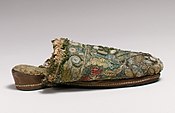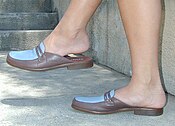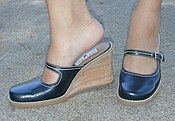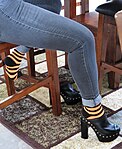Mule (shoe)
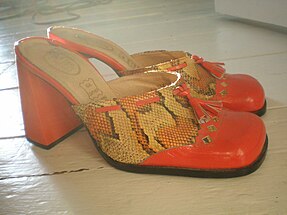
Muleis a style ofshoethat has no back or constraint around the foot's heel. Mules have a history going back toAncient Romebut were not popularly worn until sixteenth-century Europe.[citation needed]There, mules were bedroom slippers and not worn in public. Through the centuries, mules have changed in style and purpose and are no longer just boudoir shoes but are worn at any time, for any occasion. In addition to Western examples, mules come from cultures such as Turkey and Egypt, and appear in popular culture, from famous paintings to iconic celebrities' shoes.
Name
[edit]
TheEnglishwordmule—originally writtenmoyle—comes fromFrench,which was using it specifically for women's slippers with an open heel since at least 1556.[1]This sense seems to have been mixed at the time with the idea ofany shoe with an especially thick sole.[2]Medieval Latinmule([ˈmuːle],MOO-lay) was a variant spelling ofmulae,thepluralofmula,used byc. 700forslippersgenerally.[1]This name in turn seems to have derived from theClassicalcalceus mulleus( "redcalceus"), whose color name was taken from the much-prizedredandstriped red mullet fish.[1]It is much disputed whether themulleusproperly referred to the specialsenatorialshoe (calceus senatorius) or the older shoe particular to Rome'spatrician class(calceus patricius) since they both seem to have usually been dyed, may have varied over time,[3]and Roman colors—particularly around items dyed withTyrian purple—could encompass a large range of distinct shades. (The fish's name itself is cognate with theGreekmélas(μέλας), usually intendingblack.)[1]In any case, the connection to the later use of the name for slippers may have been that the aristocratic calcei—particularly the luxuriousmulleus—seem to have had a thicker-than-normal sole.[4]
History
[edit]
Mules of the 16th century to the 19th century were bedroom or boudoir slippers worn inside and not out in public. Accordingly, mules were worn with dressing gowns and typically matched the loose outfits by having the same comfort.[citation needed]The early mules did not have any distinguishable features.[5]

This style of shoe has a storied history: when Comtesse d’Olonne, the risqué society beauty, wore a soft red pair of mules to church in 1694 – daringly peeping from beneath her richly-embellished skirt – it paved the way for the style.[6]
While mules have been worn since the 15th century to the present day, their popularity has not always been constant.[citation needed]They were typical indoor shoes for both men and women in the early 1700s. By the 1720s to the end of the century, mules were the most popular indoor slipper.Fashion platesthat exist from the end of the 1790s describe women wearing mules but are not seen due to the long lengths of the contemporarypetticoats.Therefore, they were popular by the end of the 1700 but not as visible. In the beginning of the 1800s mules went out of style. In the mid to early 1800s, they rose in popularity again.[7]
In the 1860s, prostitutes wore mules in the brothels. The public avoided wearing them.[8]
"Ballin' The Jack," also known as aSpring-o-Latormule, attributed to theHerbert Levine Company,where anelasticstrip in the footbed that bridged the ball of the foot to the arch, allowed the wearer to keep the shoes securely on while wearing stockings, despite the lack of any straps at the side or back of the shoes.[9]Through much of the 1950s and 1960s a wide range of shoe designers used Herbert Levine's Spring-o-Lator technology in their shoe lines.
In the late 20th century, mules were again in fashion as they embraced the trends. They were especially popular during the end of the 1990s in the high-fashion as elite designers put their own touch on the mule.[10]
The 21st century has both accepted and rejected the mule trend.[clarification needed]Most recently,Elle magazinecalled mules the shoe of 2017.[11]
Styles
[edit]
Mules have changed in style over time. In the fifteenth century mules fromVenicewere stilted and resembled chopines.[12]Their toes were of all shapes: round, square and forked. The heel similarly was not constrained in height.Heelsranged from 1 5/8 inches to 2 ½ inches. Mules were embroidered across centuries from 1550 to 1700.[13]For example, Florentine embroidery, which is a flame stitch of various lengths, was popular during the 18th century.[14]Throughout the 1700s, mules were regularly heeled and worn by both men and women.[5]Between 1720 and 1790 the shoe structure itself was relatively dull and boring not to distract from eye-catchy buckles.[7]By 1850s, heeled mules were less frequent for men. From 1885 to 1910, the trend of large buckles and elaborate trims was replaced by less decorated low heeled leather and felt shoes.[7]

In the twentieth century wartime mules of the 1940s were made of lino,oilcloth,felt,compounds of raffia,rattan,bark or synthetic hemp.[15]1950s mules were made from plastic and decorated with feathers. Themaraboumule promoted the time periods "sex-kitten" ideals.[16]The styles for mules in the 1960s and in the 1980s mirrored the shoe trends of their respective decades. For the 1960s, mules had angular shapes and pointy toes.[17]In the 1980s, this meant that mules were colorful, opulent, and highly accessorized with jewels.[18]
Mules for men
[edit]Mules not only came in different styles and various decorations, but also can be categorized by distinct types. In the nineteenth century, two male slippers were very popular mules. In the late 1880s, a very popular version of the mule at the time in England was the Albert.[5]In addition to the Albert, the Alfred was also a man's boudoir, or morning slipper. This name comes from Daniel Green and Company 1892's "Alfred Dolge's Felt Slippers and Shoes."[5]
Mules in the East
[edit]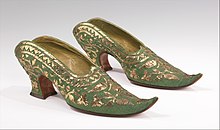
Mules also appear in eastern cultures. This history is similarly rich originating from the 800s and still present today. In eighth century Egypt, mules are depicted on gravestones and seem to be made of red kid.[12]Iranian mules from 1800 to 1889 were made of velvet, leather, silk, metal thread. They are shaped like a fish.[19]A mule from Turkey in theMetropolitan Museum'scollection is made of wood, leather, metal, and silk.[20]Mules from India were made from cow, buffalo or goat hide, fur, silk, wool, or cotton fiber, velvets, brocade and reeds and grass. Similar to the European examples, mules in India were embroidered and embellished with tassels and appliqué. In South Asia, a jutti is a type of shoe that is similar to the mule because it does not have backs.[21]Sometimes, mules resemble Turkishbabouchebecause of the use of Near Eastern fabrics. For example, Pierre Yantorny's mules designed for Rita de Acosta Lydig are made of an identical to other Near Eastern footwear. She potentially wore these shoes with a harem dress, further illustrating Eastern culture.[22]
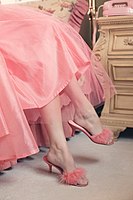
In popular culture
[edit]
Mules have been associated with several celebrities.Queen Henrietta Maria,wife of Charles I famously wore an embroidered pair of mules in the 17th century.[13]InÉdouard Manet's 1863 paintingOlympia,the central woman wears mules in bed. Her shoes connect to a type of slipper (chausson), which was slang for "old prostitute".[23]During the 1950s, iconic actresses likeMarilyn Monroe,Joan Fontaine,andJayne Russelwore the marabou mules in their films and daily lives. For example, Marilyn Monroe wore them inThe Seven Year Itch.[24]Carrie BradshawfromSex and the Cityfrequently wore mules. InMarie Claire's list of the top 32 Carrie Bradshaw shoes, six pairs are mules.[25]
In 2017, many celebrities and models were sighted wearing versions of the mules.Gigi Hadiddesigned a mule forStuart Weitzman's spring 2017 collection.[26]Beyoncé's Instagram post of her wearingGivenchymules received over 2 million likes.[27]Gucci's Princetown loafer is a version of a mule worn by both men and women. In 2015, a version of this shoe was lined with kangaroo fur, which stirred anti fur activists. These shoes were snapped on celebrities' social media platforms fromMarc JacobstoLeandra Medineof Man Repeller.[28]
Gallery
[edit]-
Early 17th century mule
-
1750 Mules made of silk
-
18th century mules
-
Red and animal skin high heeled mules
-
Woman's loafer style mules with a flat heel
-
Woman's Maryjane style mules with a wedge heel
-
Various styles of mules in a shop window
-
Birkenstock mules
-
High heeled and studded mule
References
[edit]- ^abcd"mule,n.²",Oxford English Dictionary,Oxford: Oxford University Press, 2022.
- ^Higgins, John (1585), "Mulleus",Junius' Nomenclator.
- ^Ryan, Francis Xavier (1998),Rank and Participation in the Republican Senate,Stuttgart: Franz Steiner Verlag, pp.55–56,ISBN3-515-07093-1.
- ^Purser, Louis Claude(1890),"Calceus",A Dictionary of Greek and Roman Antiquities,London: William Wayte.
- ^abcdRexford, Nancy. Womens Shoes in America, 1795–1830. Kent: Kent State University Press, 2000.
- ^Marshall, Shonagh (10 May 2016)."A Brief History of the Mule".Personal.utulsa.edu.
- ^abcSwann, June. Shoes. London: B.T. Batsford, 1991.
- ^Stevens, Sarah C., and Margaret T. Ordoñez. "Fashionable and Work Shoes from a Nineteenth-Century Boston Privy." Historical Archaeology 39, no. 4 (2005): 9–25.JSTOR25617280.
- ^"Accession #1973.276.24a, b: Herbert Levine Ballin' The Jack shoes, 1952".Metropolitan Museum of Art.Retrieved25 July2010."Accession #1973.276.1: Herbert Levine Ballin' The Jack shoes, 1952".Metropolitan Museum of Art.Retrieved25 July2010."Accession #1973.276.2: Herbert Levine Ballin' The Jack shoes, 1952".Metropolitan Museum of Art.Retrieved25 July2010."Accession #1977.287.37a, b: Herbert Levine Ballin' The Jack shoes, 1955".Metropolitan Museum of Art.Retrieved25 July2010.
- ^"Poirete | Blahnik, Manolo".Collections.van.ac.uk.
- ^"A Vintage Barbie Mule is the Shoe to Own This Summer".Elle.com.23 March 2017.
- ^abWalford, Jonathan. "Shoes, Women's."In The Berg Companion to Fashion, edited by Valerie Steele. Oxford: Bloomsbury Academic, 2010. Accessed October 30, 2017.
- ^ab"Pair of shoes - V&A Search the Collections".V and A Collections.13 December 2018.Retrieved13 December2018.
- ^"Mules".Metmuseum.org.Retrieved13 December2018.
- ^Weber, Eugen. "Review:Fashion under the Occupationby Dominique Veillon, Miriam Kochan. "The English Historical Review, vol. 118, no. 477, 2003, pp. 841–842.JSTOR3489397
- ^"Mules".Metmuseum.org.
- ^"Mules".Metmuseum.org.Retrieved13 December2018.
- ^"Luxury - Manolo Blahnik".Sites.fitnyc.edu.Retrieved13 December2018.
- ^"Pair of shoes - - V&A Search the Collections".V and A Collections.13 December 2018.Retrieved13 December2018.
- ^"Mules".Metmuseum.org.Retrieved13 December2018.
- ^1. Jain-Neubauer, Jutta. "South Asian Footwear: History, Tradition, and contemporary Trends." In Berg Encyclopedia of World Dress and Fashion: South Asia and Southeast Asia, edited by Jasleen Dhamija, 177–182. Oxford: Bloomsbury Academic, 2010. Accessed October 30, 2017.doi:10.2752/BEWDF/EDch4024.
- ^"Mules".Metmuseum.org.Retrieved13 December2018.
- ^Dolan, Therese. "Fringe Benefits: Manet's Olympia and Her Shawl" The Art Bulletin, 97:4, 2015 409–429.doi:10.1080/00043079.2015.1043828
- ^"Annex-Monroe, Marilyn (Seven Year Itch)".Doctormacro.com.
- ^GOULD, Hallie (25 March 2014)."An Ode to Carrie Bradshaw's Epic Shoe Game".Marieclaire.com.
- ^Rutherford, Chrissy (15 November 2017)."Gigi Hadid's New Shoe Collab with Stuart Weitzman Is Here".Harper's BAZAAR.Retrieved13 December2018.
- ^Allen, Rachael (4 May 2017)."Shop the Givenchy Mules Beyoncé Wears in Her Stunning Instagram Photos".Footwearnews.com.Retrieved13 December2018.
- ^Hirschmiller, Stephanie (12 October 2017)."Gucci's Going Fur-Free — Is This Fur-Lined Mule an Endangered Species?".Footwearnews.com.Retrieved13 December2018.
External links
[edit]![]() Media related toMulesat Wikimedia Commons
Media related toMulesat Wikimedia Commons

